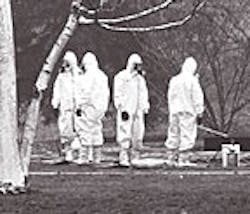WV Residents Fear Corporate Dump is Causing Cancer
"Government assurances and logical explanations have done little to relieve Gail Ferrell of her uneasy memories of an evening in 1987 when a convoy of 27 heavy, industrial-looking tanker trucks began moving up the hollow above her home here," begins a report filed today by Associated Press writer Martha Bryson Hodel.
"Sometime after daylight the next morning, landowner Irene Steele heard about the trucks and asked Ferrell and her sister to go along as she confronted the trespassers on her property at the head of what is known as Chafin Hollow," Hodel continued, summarizing the Chauncey, West Virginia resident's ordeal.
"She took off up that hollow like a rocket. She was hopping mad," Ferrell recalled first-hand. "They'd bulldozed over some timber off to one side, and she said she hadn't given anyone permission to cut timber."
"What she saw a few minutes later was more worrisome," Hodel relayed. "The trucks, most without any kind of corporate identification, were still on Steele's property at the head of Chafin Hollow …The work crews were dressed head-to-toe in white, protective gear. Only their eyes visible through clear face plates."
Two trucks bore corporate logos: one was a truck from Halliburton, a company that services oil and gas wells. A second truck was labeled Allegheny Nuclear Systems.
"They were pumping something into the ground that was creating vapors all around, like clouds of steam," Ferrell told Hodel. But it wasn't steam.
"It smelled something awful and it made our eyes sting," she said. "We pulled our coats up over our faces to cut the fumes."
Chafin Hollow, also known as Miller's Branch, feeds a tributary of Island Creek and the Guyandotte River. The hollow opens out into bottom land that is the site of Chauncey.
Ferrell recalls that 1987 incident now with a heavy heart. Last year, her neighbor Carlene Mowery began a count of Chauncey residents who had died of cancer.
"We were sitting up in the hospital with a friend who was dying of cancer and we started counting them up," she told Hodel. "In just a few minutes, we had listed 52 people we knew who had died from cancer. And I thought, 'This needs to be looked at.'"
With a little additional effort, Mowery and her neighbors compiled a list of about 180 cancer victims who had once lived or worked in Chauncey, now with a population of about 250.
Sadly, the 1987 incident is not the only source of concern for Chauncey residents.
An abandoned electrical power station, now empty except for a flooded basement, is filled with polychlorinated bi-phenols, or PCBs, which once were used to cool electrical transformers until they were banned by the government as a dangerous, cancer-causing substance.
The power station is next door to the Omar Elementary School, which residents say was built on the site of an old town dump once used by Omar Mercantile. Carew Ferrell, Gail Ferrell's husband, worked for Omar Mercantile and recalls using the site to dispose of the remains of lead-based paints and opened bags of pesticides that could not be sold.
Among the cancer victims Mowery has counted a number of teachers who spent years working at that elementary school.
The U.S. Environmental Protection Agency is conducting its second round of tests on soil and drinking water supplies from Chauncey. The initial tests revealed high levels of PCBs in the old power station and high lead levels in nearby soil, but the results from the second round of tests won't be known until January.
What is still lacking is a connection between the pollutants and the population, according to EPA spokesman Pat Boyle.
"The key thing for any pollution tests is that you have to find a pathway for human exposure," Boyle said. "So far, we can't make that connection.
"We're still looking around, following the tales and looking for some kind of connection," he said. "When we get a clearer picture of whether we have a pathway or not, we will have a public meeting with the people in Chauncey."
Boyle said the state Department of Environmental Protection and Halliburton "offered a perfectly logical explanation" for the trucks and clouds of fumes that Gail Ferrell confronted in 1987. The oil and gas well services company was using liquid nitrogen to fracture a natural gas well in an attempt to stimulate the flow of gas, Boyle said.
Liquid nitrogen quickly turns to gas when it hits the atmosphere, causing clouds of vapor. But Ferrell contends liquid nitrogen does not account for the haz-mat gear and the fumes that burned her eyes.
The EPA has been working with West Virginia's Office of Environmental Health and the Agency for Toxic Substances and Disease Registry, a division of the U.S. Centers for Disease Control in Atlanta.
"Knowing that people in that community are concerned, this is a real priority for us," said Barbara Smith of the Office of Environmental Health in Charleston. Until the surveys are complete, she cannot comment on whether there is a cancer cluster in the Chauncey area.
Researchers have long since concluded that the incidence of environmentally caused cancers is extremely low; most all cancers are the result of genetics and family heredity or so-called "lifestyle" causes like tobacco use and obesity.
According to Mowery, her tally of cancer victims did not reveal any particular kind of cancer to be dominant, nor did the age of the victims.
"It's been a variety of cancers affecting people of all ages," she said. "We've seen pancreatic cancer, cancer of the liver, the eye, breast, colon, prostate, and ovaries."
"We've got to stand up and fight back, or we're all going to die," Mowery said.
Source: The Associated Press
